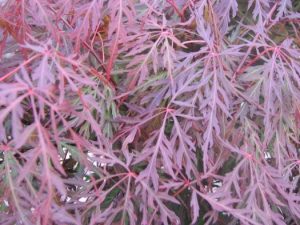A garden would be bare if there are no greens in it. Yes, I’m talking about the art of green. Hostas or Plantain Lilies are the missing pieces in the art of your garden.
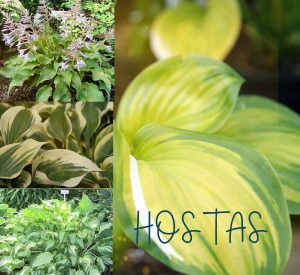
A family of plants ordinarily known as hostas, plantain Lilies and at times by the Japanese name “giboshi”.
Plantain Lilies are created as shade-tolerant foliage plants. The sort is directly placed in the family Asparagaceae, subfamily Agavoideae, and is nearby to upper east Asia (China, Japan, Korea, and the Russian Far East).
What should I do during fall
Cut back the rest of the greenery on hostas after it has kicked the basin back in fall (October or early November) in waterfront regions and up to a month sooner inland. In spite of the way that it would not hurt the plant to leave wilted foliage on the plant, the foliage gives slugs, weevils, and organized rodents a supportive safe house until spring.
This video explains why fall is the best planting time for a fruitful garden of Hostas.
How to plant Hostas
- Buy hostas as dormant, uncovered root divisions or pruned plants in the spring.
- Set the plants with the crown even with the encompassing soil and the developing tips noticeable at the dirt surface.
- If purchasing pruned hostas, plant them at a similar soil level as in the pot.
- Gently hose the dirt around the plants and water until the dirt is sodden/moist.
What are the top best hostas (mostly for gardeners)?
With such a large variety of extraordinary hosta to look over, making a list of ten top picks ended up being an overwhelming assignment. As I walked my nurseries, such a large number of hostas caught my attention and decided for a position on our preference.
1.) Hosta “Queen of the seas” 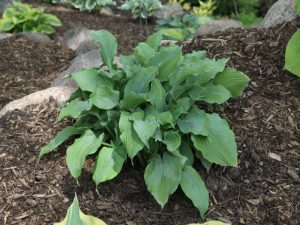
You can see a lovely building bunch of blue-dark leaves, profoundly ribbed with pie outside layer edges. Stunning as it spreads out in spring and a telling nearness throughout the entire season. This huge selection is a head-turner in the obscure nursery with its tall, upstanding structure and blue-green, heart-molded, wavy-edged leaves.
2.) Hosta “Liberty” 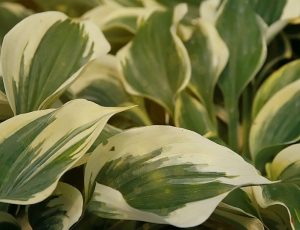
This hosta has Dark blue-green leaves with a wide edge of the brilliant yellow. For instance, its size, splendid variegation, and structure make it a stunning plant that is a point of convergence in any greenhouse. Also, it’s ideal for the shade gardens, blended with different perennials. Moreover, it’s best for small and large gardens which is a good way to take away stress.
3.) Hosta “Guacamole” 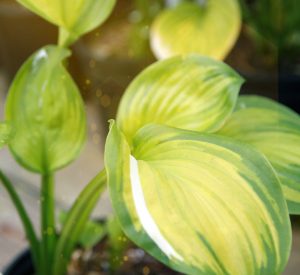
Its green-edged chartreuse leaves have a smooth sparkle that makes them look springtime crisp all through the developing season. The second: its huge flowers are fragrant! Additionally, this hosta is a quick grower and can take a lot of sunlight.
A fast grower that showcases great sun resistance and exhibits greater sun tolerance. Hostas are very easy to propagate through division because you can do it at any time during the growing season with little or no effect on the growth of the parent plant.
4.) Hosta “Allegan Fog”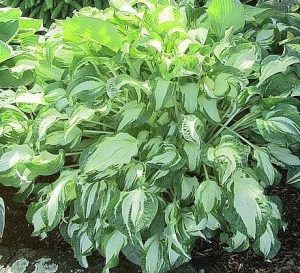
Tenderly rippled leaves with a bent tip and variegation that changes as the season changes. The leaves are sporadically margined with dull green; the focuses are white in spring, changing to light green spotted and clouded with darker green. Hosta ‘Allegan Fog’ is a medium Hosta that has lavender flowers and develops into equal parts shade. There is a slight groove between the edge and focal point of the leaf giving the leaf a sewed appearance. The white focuses of ‘Allegan Fog’ are dotted with green giving the leaves a foggy appearance.
5.) Hosta “Little Miss Magic” 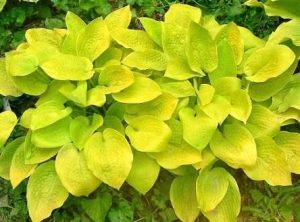
The spring leaves of this little excellence are brilliant yellow! Add to that the spear molded type of its undulated leaves, and you have garden flawlessness.
Hosta ‘Little Miss Magic’ is a little medium Hosta that has lavender flowers and develops down the middle shade/conceals. The tallness is 25 to 30 cm and the development is medium.
6.) Hosta ‘Duke of Cornwall 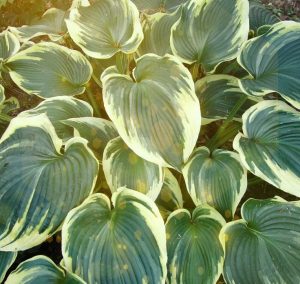
These huge, heart-formed dull green/blue leaves have a wide, feathered light green edge in spring.
It forms a huge hill of yellow-margined and blue-green-focused foliage that is very slug safe.
Likely, its close white flowers open on scapes. So whenever I see a Duke of Cornwall, it reminds me of a perfect art shading of colors from darker green and white colors.
7.) Hosta “Shade Fanfare” 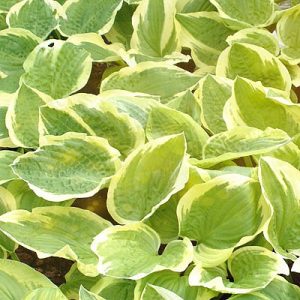
You can witness the apple green heart-formed leaves have wide velvety edges and a pointy tip. I am constantly attracted to hostas in which the leaf surface is somewhat diviner suckered.
You will notice that plants structure a solid hill of foliage which beat with lily-like flowers. This medium-sized choice has lime-green leaves with a keen white to smooth yellow edge. This is why it is easily separated in either spring or fall. Yet plants might be disregarded for quite a long time.
8.) Hosta “Raspberry Sorbet” 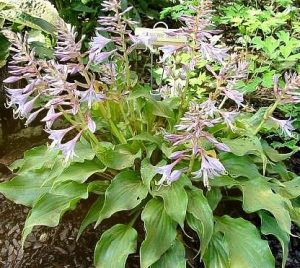
Dark green leaves are extremely shiny, and twisted, with petioles streaked with red. Its bloom scapes don’t rise straight up from the middle as in different hostas, yet rise at a point separated all around the plant.
Easily developed inequitably damp, naturally rich, well-depleted soils to a limited extent shade to full shade. Water is best applied legitimately to the soil underneath the leaves.
9.) Hosta “Little Ann” 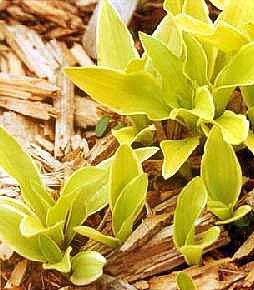
This sweet little hosta is a spreading type, with brilliant foliage and a restricted cream edge. It is valuable as an underplanting for upstanding hosta and at the front of the fringe.
“Small but elegant”, this is how I see it. You can put this hosta on sides of the designed garden for better enhancement.
The quality of this hosta differs on how you take care of them. Similarly, it may be challenging to sow this miniature plant but it’s worth it.
How to take care of Hostas
- Apply a well-adjusted, moderate discharge compost in the wake of planting or when development rises in the spring.
- The most significant thing here is to keep the dirt sodden/moist yet NOT wet. Also, remember to expel or to take away flower stalks after sprout to encourage new development.
- Clean up around the plants and expel darker leaves in the tumble to help control ailments and slugs.
- Transplant and isolation are best done in late winter when the leaves simply start to develop.
Are you looking for Plantain Lilies? Visit Far West Turf & Nursery in Woodland, Washington. We have various numbers of Hostas in SW Washington that you can choose from.
What is Daylily? 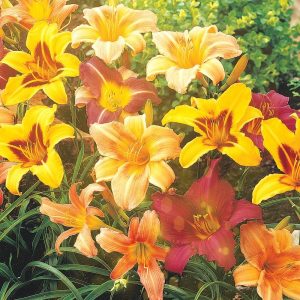
There are many types of perennial plants in the world but, the one that stands out is the ever-perfect – Daylily. Also called the “sure bet” and “perfect perennial,” these colorful flowers are perfect for beginners because they can survive through almost anything, and require just with little maintenance. While the buds will sprout for one day, every stem regularly grows a few blossoms that will prosper on various occasions. Hardly any nursery perennials are simpler to develop than daylilies. They require in any event six hours of daylight and a sensibly prolific soil, however generally are undemanding. Topdressing with decent manure in the spring as plants develop and more than once throughout the mid-year to guarantee great sprout show.
To know more about the various kinds of Perrenial, you may check it out here.
How to select the best Daylily for you?
Here are a few unique types of daylilies, including the universal light orange roadside lily (Hemerocallis fulva), the night-sprouting Hemerocallis citrina, and the fragrant lemon lily (Hemerocallis flava). The vast majority of the daylilies planted by home nursery workers are half and half cultivars.
Blossom reproducers have had a field day with daylilies and there are presently a huge number of named cultivars. These cultivars can be assembled in an assortment of ways: by blossom time that is early, mid and late, bloom shading, scape tallness (1.5-3ft tall), and blossom structure.
By picking early-, mid-, and late-blossoming cultivars, you can have daylily blossoms sprouting through the majority of the mid-year. If you additionally blend different statures, blossom hues, and bloom shapes, you can appreciate new and various blossoms every day. Proficient horticulturists separate daylilies into a few extra classes. Here is a portion of the terms you may experience:
Diploid
These cultivars have 22 chromosomes in the plant. They will, in general, have progressively various, yet littler blooms than tetraploids, and an agile, antiquated structure. Some twofold blossomed daylilies are diploids. One set of 11 comes from the egg cell, one set from the sperm cell in the pollen.
Tetraploid
These daylilies have 44 chromosomes. Tetraploid daylilies will, in general, have bigger, more seriously hued blooms than diploids. They’re likewise upheld by more grounded, sturdier scapes.
Miniature
These reduced assortments run from 12 to 25 inches tall. Blooms are littler, as well. They’re phenomenal for little spaces and for planting legitimately in the enduring fringe.
Dormant
The foliage of these cultivars kicks the bucket back to the ground in fall paying little mind to the climate. These cultivars develop best in virus atmospheres. Most daylily cultivars fall in this classification.
Evergreen/Semi-Evergreen
Some daylilies have foliage that stays evergreen or semi-evergreen all winter in mellow zones. These cultivars are best adjusted to warm-atmosphere regions.
Reblooming
Some daylily cultivars will sprout various occasions throughout the late spring. When all is said in done, daylilies have a fundamental blossom period in summer, trailed by irregular sprouts, regularly until ice. Expelling the blurred bloom heads energizes reblooming.
Now, let us talk about taking care of it.
Daylily Basics
Best times to plant: Plant in full sun for the most sprouts. Daylilies endure pretty much any well-depleted soil, however for ideal outcomes, work in heaps of natural issue, before planting. Water profoundly, and after that mulch with 2 to 3 crawls of ground bark or pine straw.
- Daylilies blossom best when planted in full sun, on soggy, yet well-depleted soil. In hot atmospheres, dim hued cultivars ought to get some evening shade to enable them to hold their blossom shading. At the point when planted in the right area, daylilies will blossom for quite a long time with little consideration. They don’t require treatment other than a yearly expansion of fertilizer.
- On the off chance that purchasing daylilies via mail, plant them inside a couple of long periods of accepting them.
- Alter the dirt with manure before planting. Space plants 12 to 18 inches separated and plant so the crown is around 1 inch underneath the dirt surface. Water well and mulch with bark or straw to monitor dampness and keep weeds from developing. Albeit strong once settled, youthful transplants ought to be kept free from weeds and very much watered the principal year.
- Daylilies have a couple of nuisances. Be that as it may, another daylily infection a sort of rust has been spreading all through the area, assaulting numerous plants. To control this illness, keep the region around daylilies open and breezy, expel ailing foliage, and water plants when precipitation is lacking.
- In northern areas, newly planted daylilies can be mulched in late fall. This is important for young plants which otherwise may be heaved out of the ground the first winter. Dead foliage can be removed in spring unless it was diseased. In that case, it is best to remove it in the fall.
How do you select the best Daylily? Have you done any of these DayLily basics? Feel free to share your DayLily journey in the comments!
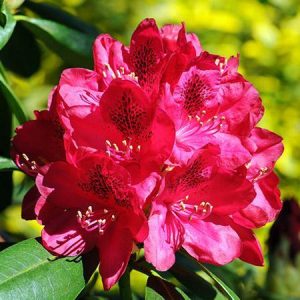 What is Rhododendron?
What is Rhododendron?
Rhododendron is a genus in the heath plant family (Ericaceae). It is a large genus with anywhere from 800 to over 1,100 wild species. The name Rhododendron comes from the Greek words, (“rodon” which means “rose”, and “dendron” which means “tree”), hence it is called Rose Tree. The Rhododendron species vast majority are native in the North Temperate Zone, especially in the moist acid soil of the eastern Himalaya and Southeast Asia, to the mountains of New Guinea. The flowers of Rhododendron are usually produced in trusses. Rhododendrons are also referred to as the King of Shrubs since Rhododendrons are regarded by many as the best flowering evergreen plants for temperate zones and landscapes.
Rhododendrons are known by many for its big leathery leafed shrubs with round clusters of white, pink and purple blooms. In Nepal, Rhododendron is the national flower, and in India, it is the state flower of Sikkim.
Rhododendrons are very dangerous, all parts of it, especially its leaves. It will show symptoms of stomach irritation, abdominal pain, abnormal heart rate, and rhythm, convulsions, coma, and death. Its honey should not be consumed as it is also toxic.
When should I plant Rhododendrons?
Best time to plant the Rhododendrons is in Spring or Fall. Its roots seldom extend over twelve inches deep, so planting them deeper than twelve inches will prevent it from getting enough air. The chief killer of Rhododendrons is wet soil. It needs moist and well-drained soil, but not waterlogged soil.
Best to apply a layer of compost under the shrub each spring. A two-inch layer of mulch is to be added to retain moisture and control the weeds, keeping much a few inches away from the trunk. In summer, water the plants if rainfall is less than 1 inch per week. In regions experiencing severe winters, protect evergreen Rhododendrons in the fall by wrapping burlap around them. Pruning is rarely needed and is done only to remove dead, damaged, or diseased branches anytime. However, when reducing height, it should be done after flowering in Spring. The Rhododendrons are not prone to any insects and diseases.
To learn more about Rhododendrons, don’t hesitate to reach out to us. We are more willing to help.
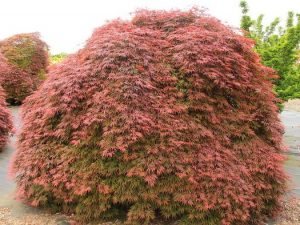 Acer palmatum Orangeola is an outstanding specie of its many Laceleaf Japanese Maples. This award-winning Orangeola Japanese Maple is one of the most admired laceleaf Japanese maples because of its astonishing leaf color. This small tree holds its beautiful foliage color in all seasons. In spring, its foliage emerges as bright red-orange and then turns to reddish-green with orange highlights in summer. Foliage color in fall is fiery orange to red.
Acer palmatum Orangeola is an outstanding specie of its many Laceleaf Japanese Maples. This award-winning Orangeola Japanese Maple is one of the most admired laceleaf Japanese maples because of its astonishing leaf color. This small tree holds its beautiful foliage color in all seasons. In spring, its foliage emerges as bright red-orange and then turns to reddish-green with orange highlights in summer. Foliage color in fall is fiery orange to red.
This small tree is native to the woodlands of Japan and Korea. Acer Palmatum Orangeola has a dissectum type foliage that gives an excellent lacy appearance. It has an unusual habit, an upright form, but the branches are also weeping, making a beautiful mound of cascading branches. It is not wide-spreading making it a perfect choice for containers.
How To Plant Orangeola
This plant grows well in well-drained and rich soils. It doesn’t require much pruning and is low maintenance. If pruning is necessary, it is best to be pruned during the dormant season, like summer, when its leaves are mature and fully developed. Avoid pruning in spring as the sap is running. This is also to avoid the tree from bleeding sap.
Fertilization
The best time to fertilize is in spring before the leaves emerge. Among all other Japanese Maples, Acer Palmatum Orangeola is perhaps the much more heat resistant than many other varieties. Although heat resistant and can tolerate full sun, its best leaf color shows when in partial shade.
Size
This small tree can grow to 8 feet in height and spread in maturity, with staking it can be grown much taller if needed. It has a slightly faster growth rate compared to its other varieties. It has no significant pests and diseases, but may be affected by horse chestnut scale, aphids, and verticillium wilt. Because the tree has a smaller size, it is ideal for planting in a smaller garden or in a pot.
Do you want to know more about Acer Palmatum Orangeola? Contact us so we can provide you more information about it.
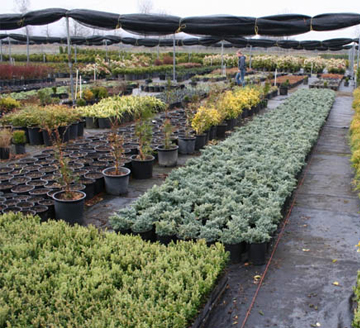
First Annual Memorial Day Landscaping Plants Sale Saturday May 25, 2019 – Monday May 27, 2019. We have the largest selection of landscaping plants and Trees in SW Washington. Premium quality at farm direct pricing. 10 acres of plants and trees to select from.
We’re celebrating this Memorial Day weekend with a SALE to get your Yards looking great again …
Memorial Day Pricing: For every $100 of plants you purchase get an additional $25 FREE (All nursery plants and trees are on sale).
Sale Hours
- Saturday 7:30-5PM
- Sunday 9AM-5PM
- Monday 7:30-5PM
All nursery plants and trees are on sale! Wide selection includes
- Japanese Maples
- Fruit Trees
- Shade Trees
- Conifers
- Lilacs
- Azaleas
- Rhododendrons
- Boxwood
- Ornamental Grasses
- Bush Roses-: Many varieties including the popular Knock Out® and Drift® varieties
- And Much, Much More!
We are located at 35306 Northwest Toenjes Road, Woodland, WA 98674 (Between Woodland and La Center off NW Pacific Highway)
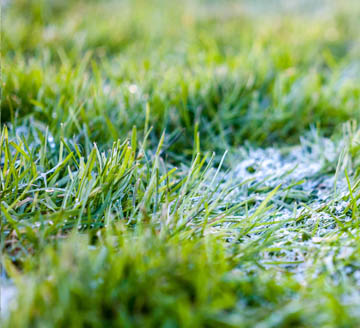
Improve curb appeal and boost your home value. You can do a little or a complete makeover.
Install sod and plants if you are getting ready to sell your home.
Great sod installation video showing techniques on how to install sod. Sod gives an instant lawn area and it is easy to install
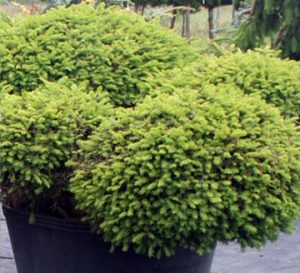
It’s December and we have had more than one hard frost. The perennials and ornamental grasses have died back. The leaves are off the tree. If not for the dwarf conifers, your garden would be barren. During the winter months it is your evergreen shrubs that add the texture and color that are the mainstays of your winter garden.
Dwarf conifers can take the form of pillars, round balls or flat ground covers that add that visual punch that is needed for your winter garden.
Green Arrow Weeping Alaska Cedar: (Chamaecyparis nootkatensis) Tall and narrow growing to 20 feet in 10 years.
Dwarf Colorado Blue Spruce: (Picea p. ‘Glauca Globosa’) Globe shaped conifer growing to 3-5 feet with bright blue color. Hardy down to -40 degrees F.
Weeping White Pine (Pinus strobus ‘Pendula’) Grows to 15 feet tall with a 10 foot width with graceful weeping branches. It has blue green foliage with long ornamental needles.
Weeping Blue Atlas Cedar (Cedrus libani (ssp.atlantica)’Glauca Pendula’). Makes an ideal specimen tree with its drooping and twisted branches. Powdery blue needles are attention grabbing. 10 feet tall and 15-20 feet wide at maturity.
Great overview video on how to prepare and install a new sod lawn. For more step by step instructions please go to our step by step sod installation instructions. Remember to properly install a new sod lawn follow these simple steps.
1. Test your soil and then add in fertilizer, lime and any necessary soil amendments.
2. Rototill or hand till the soil.
3. Level and compact the soil.
4. Moisten and install your new sod.
5. Roll to compact your new sod into the soil.
6. Keep watered and stay off the grass until rooted.
For high quality sod and personal attention and advice, come to the Far West Turf Farm located in Woodland, Washington. Located just North of Portland, Oregon and your perfect source for Portland Sod. Call us at (360) 263-4700 for more information.

Is your pet stopping you from having a beautiful, lush green garden? You don’t have to worry any more. There are ways to create a Dog-Friendly Yard which is not only beautiful but also enjoyable for your pet too.
You need to achieve balance between your landscaping design and your dog’s behaviors, habits and personalities. The following tips will provide you detailed information on creation and maintenance of Dog-Friendly Yards. Remember that every dog is different and has distinct characteristics and personalities. It is important to design landscaping in a way that your dog enjoys the time spent in the garden and at the same time gets some exercise and be able to perform their fun activities.
Digging: Does your dog like to dig? If so it is important to create a spot away from your plants in a shady area so that digging activity there and doesn’t disturb your plants. If your dog loves tunnels, they can be made with wires between plants so that the pet can enjoy in there.
Clean-up: Provide an area for your dog to relieve themselves that is covered in pea gravel or wood chips. This will save your lawn from all the dead spots when your dog chooses their own area.
Safety: Picking up of plants and pesticides for your garden is critical when you have pets. Poisonous plants and hazardous fertilizers, pesticides, chemicals should be avoided. Also plants near paths should not have thorns. Objects like garden hoses should be kept away to avoid any unwanted incidents.
Exercise: The ideal Dog-Friendly Yard should have sufficient free space for the dog to run, play and complete their fun activities. Expensive plants are not needed; instead colorful hanging baskets can be used for the eye treat. Also a well-designed dog house can be built at some corner so that your dog gets an outdoor shelter and stays cool.
Since people love their pets as much as they love their gardens, it is important to design Dog-Friendly Yards keeping in mind all the above points so that your dog, who is a member of your family, will have safe, healthier and fun atmosphere to play and complete their activities.










